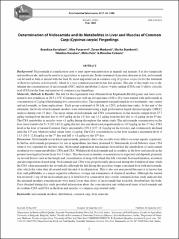Determination of Niclosamide and its Metabolites in Liver and Muscles of Common Carp (Cyprinus carpio) Fingerlings

View/
Date
2017Author
Kartalović, Brankica
Pucarević, Mira
Marković, Zoran
Stanković, Marko
Novakov, Nikolina
Pelić, Miloš
Ćirković, Miroslav
Metadata
Show full item recordAbstract
Background: Niclosamide is a medication used to treat tapeworm infestation in animals and humans. It is also lampricide
and molluscicide, and can be used in in agriculture as a pesticide. In the treatment of parasitic diseases in fish, niclosamide
can be used as bath or mixed with the feed. Its most important use in common carp (Cyprinus carpio) is for the treatment
of Bothriocephalus acheilognathi, which is a very common parasite in this fish species. The aim of this study was to determine the concentrations of niclosamide (NIC) and its metabolite 2-chloro 4-nitro aniline (CNA) and 5-chloro salycilic
acid (CSA) in the liver and muscles of common carp fingerlings.
Materials, Methods & Results: The fish for the experiment were obtained from Kapetanski Rit fish pond, and were acclimated to test conditions at 20.5 ± 1°C. Common carps with an average mass of 60 ± 10 g were treated with niclosamide in
concentration of 2 g/kg of feed during five consecutive days. The experiment was performed in two treatments: one control
and niclosamide, in three replications. Each group contained of 30 fish, in 120 L polyethylene tanks. At the end of the
treatment, the levels of niclosamide residues were determined using a high performance liquid chromatography (HPLC)
analysis during over 13 days. The mean values of niclosamide and CNA concentrations in the muscles ranged from 27.7
µg/kg starting from the first day to <0.5 µg/kg on the 11th day and 14.2 µg/kg from the first day to <1 µg/kg on the 9th day.
The CSA metabolite in muscles were <1 µg/kg during throughout the entire study. The niclosamide concentration in the
liver were found to be 51.5 (30.2-61.8) µg/kg the first day and decreased proportionally to <0.5 µg/kg on the13th day. CNA
level in the liver of treated Common Carps amounted to 170.1 (157-181) µg/kg on the first day and continuously declined
until the 13th day when recorded values were <1 µg/kg. The CSA concentrations in the liver reached a maximum level of
11.5 (10.1-12.8) µg/kg on the 7th day and fell to <1 µg/kg on the 13th day.
Discussion: Niclosamide use in fish is questionable, primarily due to the possible toxic effects on some aquatic organisms.
In Serbia, niclosamide preparation for use in aquaculture, has been produced by Veterinarski zavod Subotica since 1984
when it was registred for the first time. Niclosamid degradation mechanism showed that the metabolism of niclosamide
resulted in two main metabolites CNA and CSA. Withdrawal of niclosamide and its residues in the liver and muscle in the
present investigation lasted from 9 to 13 days. This decrease in residues concentrations is expected and depends primarily
on several factors such as the length and concentration of drug with which the fish is treated, biotransformation, excretion
and decomposition of used drug. Niclosamide and CNA were proportionally decreased during the withdrawal time, while
the CSA value increased to the seventh day although the fish during this period no longer consumed food with niclosamide,
after which the value then decreased until the end of its elimination. This is also not unexpected because it is known that
liver and gallbladder is a major organ for collection, storage and elimination of chemical residues. Although the treated
fish received 2 mg of the niclosamide per g of feed for five consecutive days results obtained in this study indicate that
the maximal residues concentrations were much lower than doses of niclosamide that each fish absorbed into the body.
Data obtained during this study provided information about the concentration and withdrawal times of niclosamide and
its residues CNA and CSA in the liver and muscles of common carp treated orally
